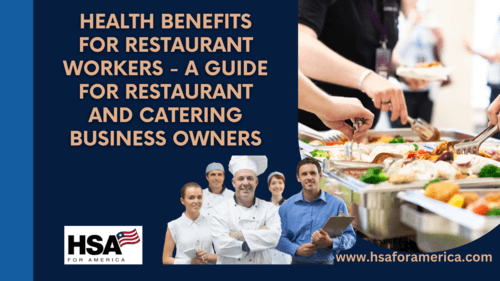For small restaurant owners, providing health benefits to employees, including servers, bus staff, and kitchen workers, is a significant challenge.

While senior managers might have access to traditional health insurance, it’s very tough for most small restaurateurs to extend this benefit to the rank and file.
As a result, too many servers, bussers, line and prep cooks and other staff are left without any kind of employee safety net.
This blog post aims to explore practical and affordable health insurance solutions for restaurant workers, addressing the unique challenges faced by small food service businesses.
The Challenge of Offering Health Benefits in the Restaurant Industry
Offering meaningful health benefits in the highly-competitive, low-margin restaurant industry is tough.
Many workers in this sector are low-wage earners and cannot afford health insurance on their own. The nature of the work, often part-time or seasonal, further complicates the availability and affordability of traditional health insurance.
Under the Affordable Care Act, businesses with fewer than 50 full-time employees are exempt from the requirement to provide a group health insurance plan for employees.
But not offering a health benefit for employees has significant costs of its own. It shows up in the form of poor recruiting and retention, high turnover costs, and low employee productivity due to absenteeism and presenteeism.
Absenteeism and Presenteeism
Absenteeism and presenteeism (working while sick) pose significant costs to the restaurant industry.
Employees without access to healthcare are more likely to miss work due to illness.
Furthermore, many low-wage employees without access to paid time off or affordable primary care work while sick – potentially affecting other staff members and customers… and escalating total costs for the employer.
According to the Centers for Disease Control, 1 in 5 restaurant workers say they’ve gone to work while experiencing symptoms of contagious illness, such as vomiting and diarrhea. And 70% of norovirus outbreaks involving contaminated food are the result of food handling from infected food service workers showing up to work sick.
This not only impacts your restaurant’s operation but also your reputation and bottom line.
Absenteeism and presenteeism due to chronic health conditions and injuries cost employers about $2,945 per year per worker, according to the Kaiser Family Foundation.
That includes losses from paid sick days, disability insurance benefits, and poor productivity while on the job.
Employees who can’t afford to see the doctor or get their prescriptions filled remain sicker for longer, and cost employers even more.
Compare Pricing on the Best Insurance Plans Available
Benefits as a Differentiator in the Restaurant Industry
Offering health benefits can be a major differentiator for restaurants, helping to attract and retain good staff.
In an industry known for high turnover, providing health benefits can enhance job satisfaction and loyalty among employees.
For the thousands of restaurant owners for whom offering a traditional group health insurance benefit is beyond their budget, here are several out-of-the-box solutions that are much more budget-friendly and more realistic for the food service industry.
Affordable Health Benefit Options for Restaurant Businesses
Health Sharing Plans as an Alternative
Health sharing plans are a more affordable non-insurance alternative to traditional group health insurance products.
Essentially, health sharing plans are non-profit associations of like-minded, health-conscious individuals who agree to help share the unexpected medical costs of fellow plan members.
These plans are much less expensive than a traditional group health insurance benefit. They can be a good fit for the many restaurants who’ve been priced out of the traditional group insurance market.
They can provide robust protection against the risk of large and catastrophic medical costs – all at a fraction of the cost of a full-fledged group health insurance product.
Many restaurant owners are turning to health sharing plans as a viable and affordable alternative to a traditional group health insurance benefit.
Note: Unlike health insurance, health sharing plans do not include immediate benefits for costs related to pre-existing conditions. They typically impose a waiting period before they will share pre-existing condition costs.
Health sharing works best for members in good health with no pre-existing conditions.
Health Reimbursement Arrangements (HRAs), Particularly QSEHRAs
One viable solution for small restaurants is to consider a Health Reimbursement Arrangement (HRA), particularly a Qualified Small Employer HRA (QSEHRA).
Designed for companies without their own group health plan, QSEHRAs allow employers to provide tax-free money to employees, who can then use these funds to pay for their own health insurance premiums.
- Contributions are tax-deductible to the business as a compensation expense.
- There is no minimum contribution requirement.
- Businesses with fewer than 50 full-time employees are eligible.
- Easy and inexpensive to administer.
This approach offers flexibility and empowers employees to choose plans that best suit their own individual needs.
Click here to learn more about offering an HRA to your own employees, or contact one of our experienced Personal Benefits Managers for a free consultation and analysis.
Direct Primary Care (DPC)
Many restaurant workers delay necessary healthcare because they can’t afford the visit to a family doctor or clinic.
Offering a Direct Primary Care (DPC) benefit can bridge this affordability gap. DPC provides employees with access to primary care services for a flat, monthly fee, without the complexities of traditional insurance.
With direct primary care, workers have no deductibles, co-pays, or co-insurance to worry about.
Offering a direct primary care membership can be an efficient, realistic, and cost-effective way to help your restaurant employees afford to see a doctor when they need to.
This helps reduce both absenteeism and presenteeism costs.
It also boosts retention and helps reduce turnover, which contributes to your business’s profitability.
To learn more about DPC, click here and read our Complete Guide to Direct Primary Care.
Voluntary and Supplemental Benefits
Many businesses offer additional benefits that are paid by employees at little or no cost to the employer.
These are called “voluntary benefits”.” Workers opt in, and pay premiums or fees themselves via payroll deduction.
Common examples of voluntary and supplemental benefits include disability insurance, accident insurance, hospital indemnity insurance, critical illness insurance.
Disability Insurance
Disability insurance steps in to replace lost income due to an illness or injury.
According to the Council for Disability Awareness, only about 5% of disabling injuries are work-related. The vast majority of disabilities are not covered under worker’s compensation insurance.
Disability insurance steps in to cover workers who can no longer work because of illnesses, car accidents, and other causes.
It’s a critical benefit to offer, and a lifesaver for those workers affected.
Accident or Hospital Indemnity Insurance
For workers living paycheck to paycheck, accident or hospital indemnity insurance can be a lifesaver.
This type of insurance ensures that employees can afford to go to the emergency room or hospital without delaying care due to financial concerns. Offering these as voluntary benefits can provide essential coverage at little or no cost to the business.
Critical Illness Insurance
Critical illness insurance pays a cash lump sum if the insured is diagnosed with a qualifying illness, such as cancer, stroke, heart attack, loss of limb or eyesight, major burns, or paralysis.
This lump sum can be used to pay for anything the insured needs. Common examples are to replace lost income, to pay insurance deductibles or health sharing Member Responsibility Amounts, to pay a caretaker, or to pay for transportation costs for medical treatment to be closer to family during recovery.
Click here to learn more about our Critical Illness Insurance benefit.
Each of these benefits are very popular among workers – even lower-wage workers. Most of them know people who’ve been injured or sick or otherwise unable to work, and so it’s easy for them to see the value in voluntary benefits like these.
The Importance of Paid Sick Time
Investing in paid sick time is crucial in the restaurant industry.
Sick workers who can afford to take a few days off are less likely to get other employees or customers sick, reducing the spread of illness. This not only benefits public health but also helps maintain a productive and healthy workforce.
Compare Pricing on the Best HealthShare Plans Available
What to Do Now
While providing health benefits in the restaurant industry is challenging, there are viable and affordable options available.
By considering solutions like QSEHRAs, health sharing plans, DPC, and voluntary benefits like accident or hospital indemnity insurance, restaurant owners can offer valuable health benefits to their employees.
This not only aids in employee retention and satisfaction but also contributes to a healthier, more productive workforce.
For personalized guidance and to explore the best health insurance options for your restaurant staff, make an appointment with a Personal Benefits Manager from HSA For America. Their expertise can help you navigate the complexities of health insurance and find a solution that works best for your business and your employees.
For Further Reading: The Most Effective Healthcare Strategies for Small Businesses With Fewer Than 50 Employees | Why Smart Employers Are Dropping Group Health for ICHRAs and DPC | SICKER SHOCK: Employers Slammed by Biggest Health Insurance Premium Cost in Years

